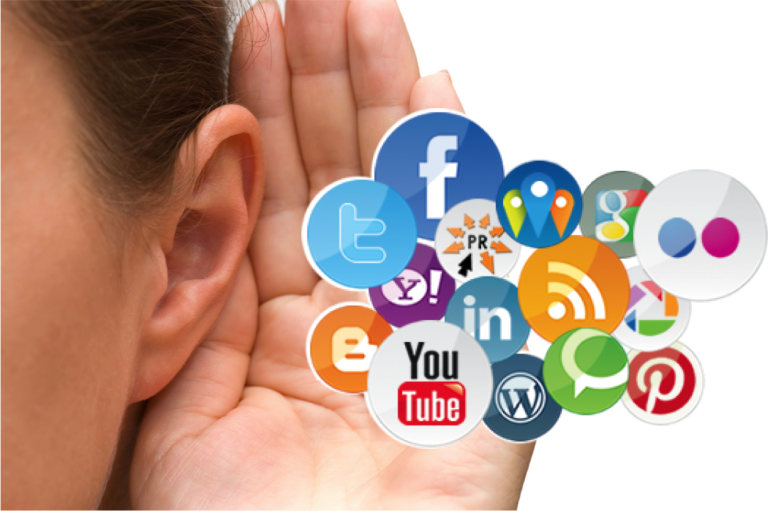Be Quiet & Listen: How & Why Your Brand Should Use Social Listening
In the fast-paced digital landscape of today, where social media reigns supreme, brands need to adopt a proactive approach to understand and engage with their audience. Enter social listening – a powerful tool that allows brands to tune in, absorb, and analyze the chatter happening across various social media platforms. This article delves into the intricacies of social listening, elucidating its significance, benefits, and why every brand should integrate it into their marketing strategy.
Defination of social listening :
Social listening encompasses a broader spectrum of online conversations, extending beyond traditional social media platforms to include forums, blogs, news sites, and other online communities. It involves monitoring and analyzing discussions related to a brand, industry, or topic across various online channels.
What is Social Listening?
Social listening, also known as social media listening, refers to the process of monitoring, analyzing, and interpreting conversations and sentiments happening across social media platforms. It goes beyond simply tracking mentions of a brand’s name or products; instead, it involves understanding the broader context of discussions, including trends, topics, and consumer preferences.
Benefits of Social Listening:
1. Insights into Consumer Sentiment:
By harnessing the power of social listening, brands can gain invaluable insights into consumer sentiment towards their products or services. By monitoring conversations, comments, and reviews, brands can gauge how their audience perceives them, identify areas for improvement, and address any concerns promptly.
2. Competitive Analysis:
In the cutthroat world of business, keeping tabs on competitors is essential for staying ahead of the curve. Social listening enables brands to monitor competitors’ activities, assess their strengths and weaknesses, and identify emerging trends within their industry. This information can inform strategic decision-making and help brands refine their own marketing strategies to outperform the competition.
3. Crisis Management:
In the age of viral content and instantaneous communication, a single negative tweet or post has the potential to snowball into a full-blown PR crisis. Social listening equips brands with the tools to detect and mitigate such crises before they escalate. By monitoring social media conversations in real-time, brands can identify brewing issues, address customer concerns promptly, and take proactive steps to protect their reputation.
4. Enhancing Customer Experience:
In today’s hyper-connected world, consumers expect brands to be responsive and attentive to their needs. Social listening enables brands to engage with customers in meaningful conversations, address their queries and concerns, and provide personalized solutions. By actively listening to their audience, brands can foster stronger relationships, build trust, and enhance the overall customer experience.
5. Informing Product Development:
Successful brands understand that innovation is key to staying relevant in a constantly evolving marketplace. Social listening provides brands with direct access to feedback and suggestions from their target audience, helping them identify emerging trends, unmet needs, and areas for product improvement. By incorporating consumer insights gleaned from social listening into their product development process, brands can create offerings that resonate with their audience and drive long-term success.
Practical Applications of Social media Listening:
Brand Monitoring:
Social listening allows brands to monitor mentions of their brand name, products, or relevant keywords across various online platforms. By tracking conversations related to their brand, brands can gain a comprehensive understanding of how they are perceived by consumers, identify brand advocates, and address any negative sentiments or issues promptly.
Trend Analysis:
Social listening enables brands to identify emerging trends, topics, and discussions within their industry or target market. By monitoring conversations and hashtags, brands can stay abreast of the latest developments, capitalize on trending topics, and adapt their marketing strategies accordingly to maintain relevance and resonance with their audience.
Audience Insights:
Understanding the needs, preferences, and behaviors of their target audience is paramount for brands seeking to establish meaningful connections and drive engagement. Social listening provides brands with valuable audience insights, allowing them to segment their audience, identify key influencers, and tailor their messaging and content to resonate with specific demographic groups.
Campaign Evaluation:
Social listening serves as a valuable tool for evaluating the effectiveness of marketing campaigns and initiatives. By tracking social media mentions, engagement metrics, and sentiment analysis, brands can measure the impact of their campaigns in real-time, identify areas for improvement, and optimize their strategies for maximum effectiveness.
Conclusion:
In conclusion, social listening is not merely a buzzword or fleeting trend; it is a strategic imperative for brands looking to thrive in today’s digital landscape. By harnessing the power of social listening, brands can gain deeper insights into consumer sentiment, stay ahead of competitors, manage crises effectively, enhance customer experience, and inform product development. In an era where communication is increasingly mediated through social media, brands that embrace social listening will undoubtedly enjoy a competitive advantage and forge stronger connections with their audience. So, it’s time to “be quiet and listen” – your audience has much to say, and by tuning in, brands can unlock a wealth of opportunities for growth and success.


